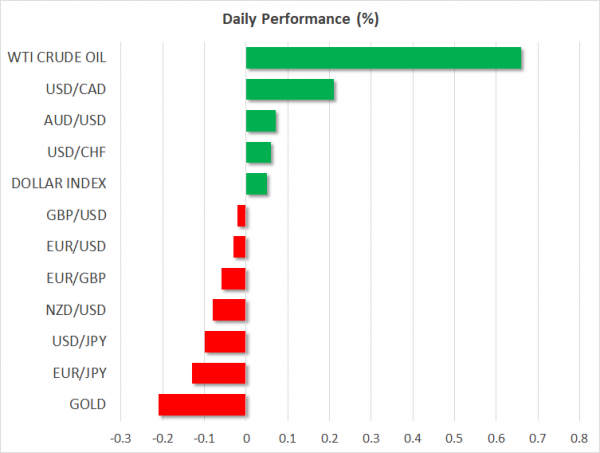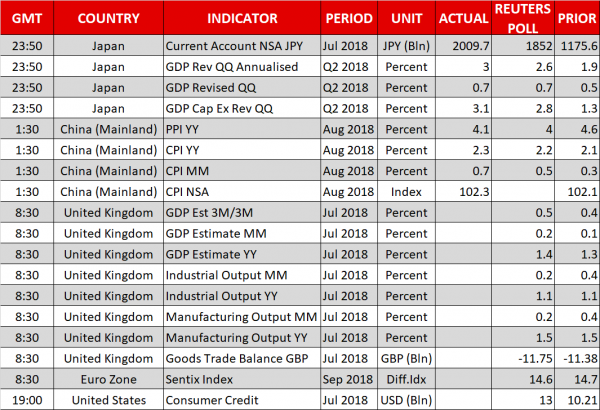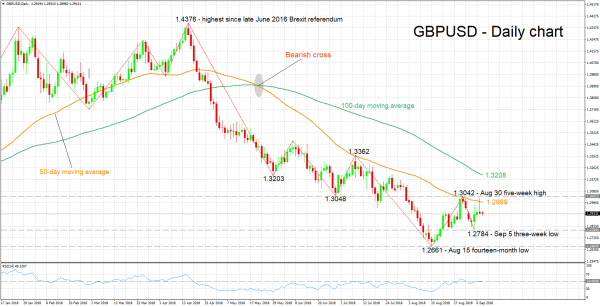Here are the latest developments in global markets:
FOREX: The US dollar index is marginally higher on Monday (+0.04%), holding onto the gains it recorded in the previous session, after a surprising acceleration in US wage growth fueled demand for the greenback. The pound also soared higher on Friday as some appeasing remarks from EU chief negotiator Barnier enhanced speculation that a Brexit deal may ultimately be delivered.
STOCKS: Wall Street closed lower on Friday, as investors’ risk appetite was curbed by some confrontational remarks by US President Trump, who threatened to impose tariffs on all Chinese imports “on short notice”. A pickup in US wage growth may have also weighed on sentiment – recall that a brief acceleration in earnings was a key factor behind the stock market’s pullback in early February. The Dow Jones (-0.31%), Nasdaq Composite (-0.25%), and S&P 500 (-0.22%) all fell modestly. As for today, futures tracking the Dow, S&P, and Nasdaq 100 are flashing green, pointing to a slightly higher open. Meanwhile, Asia was mixed on Monday, with Japan’s Nikkei 225 (+0.30%) and Topix (+0.20%) posting some gains, but the Hang Seng in Hong Kong recorded considerable losses (-1.80%). In Europe, all major indices were set for a flat open today, futures suggest.
COMMODITIES: Oil prices are higher on Monday, buoyed by a small decline in the Baker Hughes survey gauging the number of active US oil rigs on Friday. Meanwhile, a rocket attack on an Iraqi airport over the weekend may have generated some concerns for potential supply disruptions in the Middle East. WTI is up by 0.65% at $68.20 per barrel on Monday, while Brent is trading higher by 0.91% at $77.53/barrel. In precious metals, gold is lower by 0.21% at $1,193 per troy ounce. The dollar-denominated yellow metal was pressured lower by a surge in the greenback on Friday, though prices remain within the narrow range established two weeks ago, between $1,214 and $1,189.
Major movers: Dollar soars as wages pick up; Brexit optimism lifts pound
The dollar surged across the board on Friday, following the US employment report for August. Nonfarm payrolls clocked in at 201k, slightly more than the anticipated 191k, while last month’s print was revised a little lower to 147k. The unemployment rate held steady at 3.9%, missing the forecast for a downtick to 3.8%. What probably caught investors’ attention the most though, was the wages component of this report. Average hourly earnings accelerated to 2.9% in yearly terms, notably higher than the expected 2.7%, and reaching a cycle-high last seen in 2009.
Since wage growth is considered a precursor to higher inflation down the road, the pickup in earnings likely amplified speculation for a somewhat more aggressive rate-hike path by the Fed moving forward. Especially so because these data came on top of robust ISM PMIs last week, which painted a rosier picture for US economic growth in Q3. A quarter-point Fed rate increase is now fully priced in for the September 26 meeting, while the probability for a second one by year-end has risen to 70% from 63% before the jobs data, according to market-implied pricing derived from the Fed funds futures.
Meanwhile in Canada, the nation’s own employment data for August disappointed, with the unemployment rate rising by more than expected and the net change in employment dropping sharply and unexpectedly into negative territory. Combined with a strong US jobs report and no signs of meaningful progress in the US-Canada trade negotiations, dollar/loonie edged up on Friday and is also trading 0.22% higher on Monday.
In the UK, the pound ripped higher after the EU’s chief negotiator Michel Barnier was seen as softening his Brexit stance, noting he “is open” to discussing other backstop solutions for the Irish border issue – which is the main sticking point left. He added the EU is ready to “simplify” border checks at the UK-Irish border, fueling expectations that the negotiations may ultimately bear fruit as both sides have shifted to a more conciliatory tone lately. Sterling/dollar surged to briefly break above 1.3000 as the Brexit risk premium on the pound was trimmed, though the pair pared all its gains to close the day lower after the dollar surged on the back of strong wage data. The UK currency held onto its gains against the euro though, with euro/sterling ending the session notably lower.
Elsewhere, the Swedish krone traded higher versus the euro and the dollar, though not by much, as the country headed for a hung parliament following Sunday’s elections.
Day ahead: Key UK data out; eurozone’s Sentix and US consumer credit also due; trade in focus
Monday’s calendar features industrial and manufacturing output figures, as well as monthly GDP numbers out of the UK. Data on eurozone investor sentiment and US consumer credit are also due. Meanwhile, developments on global trade, predominantly the Sino-US spat, will be closely watched.
UK industrial and manufacturing output growth is anticipated to have eased on a monthly basis in July, though the annual pace of expansion for both is expected to remain steady at 1.1% and 1.5% correspondingly. Additionally, July’s trade data out of the nation are projected to show the relevant deficit widening a bit, while GDP growth for the same month is forecast to stand at 0.2% m/m, above June’s 0.1%. This would put the annual pace of growth at 1.4%, from 1.3% in June. All readings are due at 0830 GMT, though sterling is yet again anticipated to be most responsive to any Brexit headlines rather than to economic releases.
Eurozone’s Sentix index, gauging investor confidence, is expected to marginally weaken in September. The measure has been sensitive to rising trade tensions in the past.
Out of the US, consumer credit data for July will be hitting the markets at 1900 GMT.
On trade, a fresh round of US tariffs on $200 billion worth of Chinese imports may go into effect at any time, and perhaps with little warning. In the meantime, President Trump expressed readiness on Friday to levy tariffs on virtually all Chinese imports into the US. Developments will have ramifications for broader market sentiment. Also on trade, ongoing talks between the US and Canada on a new North American trade deal have yet to bear fruit.
Atlanta Fed President Raphael Bostic, a voting FOMC member in 2018, will be talking on the US economic outlook at 1400 GMT.
Lastly, a meeting between Russian President Vladimir Putin and Japanese PM Shinzo Abe may be of interest.
Technical Analysis: GBPUSD looking neutral in the short term
GBPUSD has been moving sideways in recent days. The RSI is hovering around the 50 neutral-perceived level, pointing to the absence of momentum in either direction, the upside or the downside.
Upbeat UK data later today or positive Brexit news are expected to boost the pair. Resistance to gains may take place around the current level of the 50-day moving average line at 1.2999, including the 1.30 round figure. Not far above lies the five-week high of 1.3042 from late August which may also act as a barrier to advances.
Disappointing figures or growing signs for a no-deal Brexit, are likely to exert pressure on GBPUSD. Support to losses may take place around the three-week low of 1.2784 hit on September 5, including the 1.28 handle. Steeper declines would increasingly bring into scope the fourteen-month low of 1.2661 from August 15.
















